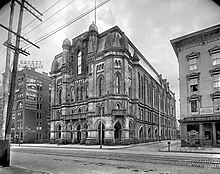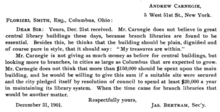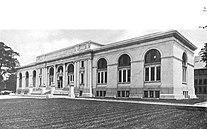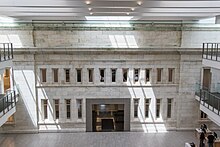
Capital University is a private university in Bexley, Ohio, United States. Capital was founded as the Theological Seminary of the Evangelical Lutheran Synod of Ohio in 1830 and later was associated with that synod's successor, the American Lutheran Church. The university has undergraduate and graduate programs, as well as a law school. Capital University is the oldest university in Central Ohio and is one of the oldest and largest Lutheran-affiliated universities in North America.

The Columbus Metropolitan Library (CML) is a public library system in Franklin County, Ohio, in the Columbus metropolitan area. The library serves an area of 872,000 residents, has a collection of 1,483,433 volumes, and circulates 17,262,267 items per year.
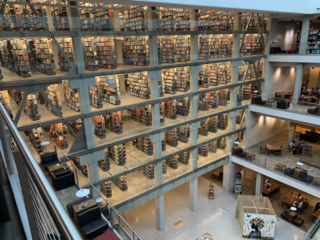
The William Oxley Thompson Memorial Library is the main library at Ohio State University's Columbus campus. It is the university's largest library and houses its main stacks, special collections, rare books and manuscripts, and many departmental subject libraries. The library was originally built in 1912, and was renovated in 1951, 1977, and 2009. It is named in honor of the university's fifth president, William Oxley Thompson.

The Greater Columbus Convention Center (GCCC) is a convention center located in Downtown Columbus, Ohio, United States, along the east side of North High Street.

Engine House No. 12 is a former fire station in the Olde Towne East neighborhood of Columbus, Ohio. Today it primarily houses Gemüt Biergarten, a German restaurant, brewery, and biergarten, with its second story used for offices. It is a contributing property to the Columbus Near East Side District, a national historic district established in 1978.

The Ohio History Center is a history museum and research center in Columbus, Ohio. It is the primary museum for Ohio's history, and is the headquarters, offices, and library of the Ohio History Connection. The building also houses Ohio's state archives, also managed by the Ohio History Connection. The museum is located at the Ohio State Fairgrounds, site of the Ohio State Fair, and a short distance north of downtown. The history center opened in 1970 as the Ohio Historical Center, moving the museum from its former site by the Ohio State University. The building was designed by Ireland & Associates in the Brutalist style. It was listed on the National Register of Historic Places along with the Ohio Village in 2023.

The Discovery District is a special improvement district in downtown Columbus, Ohio, the home of Columbus State Community College, Columbus College of Art and Design, Columbus Museum of Art, and Columbus Metropolitan Library. It is considered a cultural district because of its close proximity to higher educational campuses and art destinations. It was named to imply that the area is full of possibility due to the number of learning and creative campuses in this small area. "Culture, art, and academia converge and present the Discovery District." While not typically viewed as the most prominent Columbus neighborhood, the density of academic and arts-based institutions in this area are what make this creative campus unique.

Columbus City Hall is the city hall of Columbus, Ohio, in the city's downtown Civic Center. It contains the offices of the city's mayor, auditor, and treasurer, and the offices and chambers of Columbus City Council.

The Atlas Building, originally the Columbus Savings & Trust Building, is a high-rise building in Downtown Columbus, Ohio, built in 1905 and designed by Frank Packard. It was added to the National Register of Historic Places in 1977. The building has seen two major renovations, in 1982 and 2014.

The Delaware Public Library is a former public library in Delaware, Ohio. The building was funded by Andrew Carnegie and built in the neoclassical style. It opened to the public in 1906. The library's collection of books and volumes rapidly expanded during its operational history. By the 1970s, the Delaware Public Library started to run out of space. In 1984, a new public library was constructed, and Delaware County, Ohio started using the Delaware Public Library for office space. The building was tripled in size during a construction and restoration project that lasted from 1999 to 2001. The Delaware Public Library is currently used to house a number of Delaware County agencies, including the Delaware County Board of Commissioners.
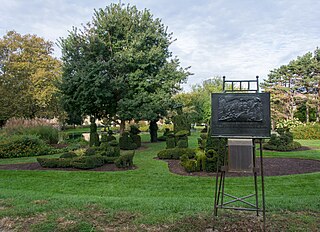
Topiary Park is a 9.2-acre (3.7 ha) public park and garden in Columbus, Ohio's Discovery District. The park's topiary garden, officially the Topiary Garden at Old Deaf School Park, is designed to depict figures from Georges Seurat's 1884 painting, A Sunday Afternoon on the Island of La Grande Jatte. It is the only park based entirely on a painting.

The Thomas J. Moyer Ohio Judicial Center is a state courthouse, office building, and library in Columbus, Ohio, in the city's downtown Civic Center. The building is the headquarters of the Supreme Court of Ohio, the state's highest court, as well as the Ohio Court of Claims and Ohio Judicial Conference. The judicial center is named after the court's former chief justice Thomas J. Moyer.

The Huntington National Bank Building is a bank and office building on Capitol Square in Downtown Columbus, Ohio. Once the headquarters to the Huntington National Bank, it now includes the company's primary lending bank, the Capitol Square Branch. It is part of the Huntington Center complex, which also contains the Huntington Center skyscraper, Huntington Plaza, and DoubleTree Hotel Guest Suites Columbus.
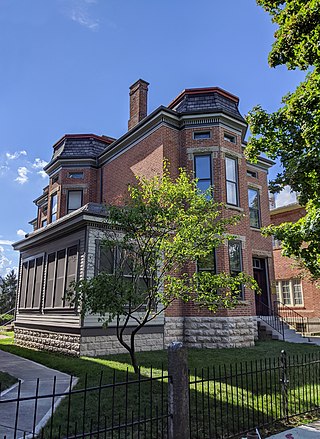
The Columbus Landmarks Foundation, known as Columbus Landmarks, is a nonprofit historic preservation organization in Columbus, Ohio. The foundation is best-known for its list of endangered sites in the city and its annual design award, given to buildings, landscapes, and other sites created or renovated in Columbus. It was established in 1977 as a project of the Junior League of Columbus, Ohio, following the demolition of the city's historic Union Station. It is headquartered at 57 Jefferson Avenue, a contributing structure in the Jefferson Avenue Historic District in Downtown Columbus.

Budd Dairy Food Hall is a food hall in the Italian Village neighborhood of Columbus, Ohio. The Cameron Mitchell Restaurants-run hall holds ten foodservice locations, three bars, and indoor, patio, and rooftop seating. It is situated in the historic Budd Dairy Company building, a former milk processing and distribution facility. The space was renovated beginning in 2018, and opened in April 2021.
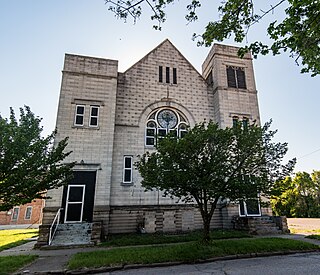
The West Side Spiritualist Church was a historic church building in Franklinton, Columbus, Ohio. The Spiritualist church was built in 1912 for the congregation of Harry Boerstler, who moved to the neighborhood in 1900 to bring hope to its working-class people. The congregation lasted until about 1948, and the building later housed the Boerstler Memorial Spiritualist Temple and the Greater Christ Temple Apostolic Church. After years of vacancy, the church building was approved to be demolished for affordable housing, to accompany an upscale mixed-use development nearby, despite opposition from preservationists.
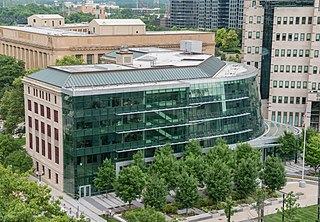
77 North Front Street is a municipal office building of Columbus, Ohio, in the city's downtown Civic Center. The building, originally built as the Central Police Station in 1930, operated in that function until 1991. After about two decades of vacancy, the structure was renovated for city agency use in 2011.
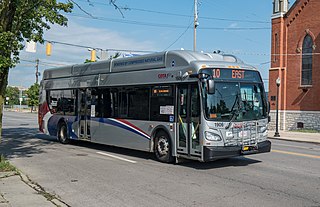
The 10 E Broad / W Broad is a Central Ohio Transit Authority (COTA) bus service in Columbus, Ohio. The line operates on Broad Street, the city's main east-west thoroughfare.
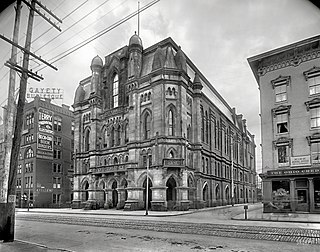
Columbus City Hall was the city hall for Columbus, Ohio, located on Capitol Square in the city's downtown. The building served the mayor and city council from its construction in 1872 until its demolition in 1921. The building was the founding site for the United Mine Workers of America in 1890. In 1928, the site became home to the Ohio Theatre, and the current Columbus City Hall opened nearby.

The Park Hotel was a hotel in Columbus, Ohio. It was later in its history known successively as the Northern Hotel, the Railway Y.M.C.A., and as the Goodale Hotel. The building stood at the northwest corner of North High Street and Goodale Street.


